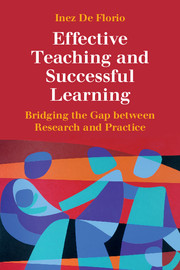Book contents
- Frontmatter
- Epigraph
- Contents
- Preface
- Introduction
- 1 Main Features of Scientific Research on Education
- 2 Important Types of Scientific Research on Education
- 3 Main Features of Evidence-based Research on Education
- 4 Meta-Analyses on Education
- 5 A Synthesis of Over 800 Meta-Analyses Relating to Achievement
- 6 Scaffolding Effective Teaching and Successful Learning
- 7 Planning and Starting the Lesson
- 8 Presenting Knowledge and Skills – Assertive Questioning
- 9 Guided and Independent Practice
- 10 Cooperative and Project-based Learning
- 11 Feedback – Reciprocal and Informative
- Concluding Remarks: Standards Need More Evidence
- References
- Index
6 - Scaffolding Effective Teaching and Successful Learning
Published online by Cambridge University Press: 05 June 2016
- Frontmatter
- Epigraph
- Contents
- Preface
- Introduction
- 1 Main Features of Scientific Research on Education
- 2 Important Types of Scientific Research on Education
- 3 Main Features of Evidence-based Research on Education
- 4 Meta-Analyses on Education
- 5 A Synthesis of Over 800 Meta-Analyses Relating to Achievement
- 6 Scaffolding Effective Teaching and Successful Learning
- 7 Planning and Starting the Lesson
- 8 Presenting Knowledge and Skills – Assertive Questioning
- 9 Guided and Independent Practice
- 10 Cooperative and Project-based Learning
- 11 Feedback – Reciprocal and Informative
- Concluding Remarks: Standards Need More Evidence
- References
- Index
Summary
Taking Hattie's model of Direct Instruction (DI) in seven major steps as a starting point, a more detailed research-based teaching model in thirty steps is presented and discussed in the following. I draw on various tried-and-trusted examples combing lesson design and instructional design. Many steps of my Model of Effective Teaching (MET) are backed up by evidence-based research. It follows the tendencies outlined by Hattie, Marzano, and other scholars. Their results are compared to those of Wellenreuther (2004, 2014), a German scientist, who draws exclusively on experimental research. Excluding correlation studies (and qualitative research), Wellenreuther is in a position to explain the results of preselected RCTs (where available) and quasi-experimental studies in more detail. On the other hand, the exclusive focus on strong experimental research limits the use of his handbook.
On the whole, the MET is not evidence-based but evidence-informed. As my model has to stand the test of practitioners, its purpose is to offer trustworthy guidelines for teachers. What teachers can reach with the help of the MET is comparable to Vygotsky's Zone of Proximal Development, or, rather, Bruner's Scaffolding (see Section 1.4). I offer a scaffold that teachers can use entirely or in part, and which they may put down when they do not need it any more (for details see Chapters 7–11).
Another important goal is connected with this overall aim. In a multilayered, complex, and changing field such as education, the personality and the responsibility of the teacher are at least as important as averaged means in form of effect sizes. The MET invites teachers to make informed decisions showing them alternatives. Practitioners, however, should not feel limited to scientific results, as these are always falsifiable.
Sometimes inflexibility and authoritarian attitudes of policy makers and school administrators, fixated on so-called evidence-based education, rub off on practitioners, causing harm to many students. Anything goes? Not at all; on the contrary, the MET challenges teachers to review and revise their teaching practices, giving up ineffective traditions and habits. Successful learning of (possibly) all students begins with effective teaching.
HATTIE'S MODEL OF DIRECT INSTRUCTION (DI)
It was not only the enormous amount of meta-analyses synthesized in Hattie's study that attracted worldwide attention.
- Type
- Chapter
- Information
- Effective Teaching and Successful LearningBridging the Gap between Research and Practice, pp. 94 - 117Publisher: Cambridge University PressPrint publication year: 2016



